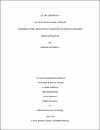Thermoelectric Behavior of Nanocrystalline Tin Selenide Nanocomposites
Abstract
Thermoelectric technology converts thermal energy to electricity. Many studies were conducted on thermoelectric materials such as Bismuth Telluride and Lead Telluride. And the goal was to achieve an average ZT >2 which is required for waste heat recovery applications. Recently Tin Selenide (SnSe) showed a promising performance with a ZT of nearly 2.6 at 923 K for its single crystal structure at the b-axis. However, single crystal SnSe is very fragile and the production of single crystal SnSe structure is a complicated and costly process. Therefore, great interest was given to polycrystalline SnSe.
In this work, the thermoelectric performance of polycrystalline SnSe was enhanced through nanostructuring and nano-composting with graphene via a cost-effective methodology. Nanocrystalline SnSe composites were successfully prepared by high energy ball milling and SPS techniques, and the structural characterization by X-ray Diffraction and Transmission Electron Microscopy revealed that the average grain size of both pristine SnSe and SnSe with Graphene was approximately (~ 10 nm). The mechanical properties were evaluated and showed an enhancement with high hardness values. The nanostructuring contributed in the enhancement of Seebeck coefficient and the highest reported value so far was obtained for pristine SnSe with 1032 μV/K at 873K. A significant improvement in ZT value was observed for the pristine nanostructured SnSe with a value of 0.9 at 873 K, and the addition of Graphene increased the ZT to 1.2 at 873 K due to the increased power factor and the lower thermal conductivity. Graphene was detected to be mainly present around the grain boundaries and this finding represents the first ever reported evidence to identify the location of graphene in a nanocrystalline TE material.
DOI/handle
http://hdl.handle.net/10576/11501Collections
- Materials Science & Technology [63 items ]


